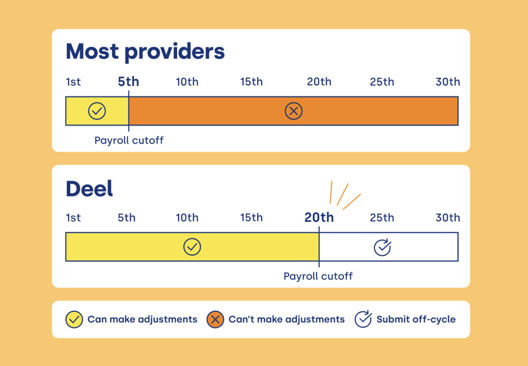
The Pros & Cons of Pay For Performance Model

Key takeaways
- Pay for performance means an employee is eligible for financial incentives on top of their base salary if they outperform a specific target or goal.
- Performance-based pay can be an excellent tactic to increase employee engagement and motivate employees to exceed expectations.
- Pay-for-performance pay can have drawbacks if implemented without getting regular feedback from employees and relying on HR tech to streamline and facilitate performance management.
Determining the best employee compensation system for a global team is a complex task, given all the factors that may influence your decision: currency fluctuations, local cost of living, tax implications, and employee expectations—just to name a few.
If you’re leaning towards performance-based pay, this guide will help you understand how pay for performance works, its pros and cons, and the best practices for its implementation.
What is pay-for-performance compensation?
Pay for performance, often referred to as P4P, is a strategic compensation approach designed to optimize employee productivity and align it with organizational objectives through a dynamic system of financial incentives.
In this compensation model, employees are motivated to exceed their performance targets as you give them an opportunity to earn more if they outperform the pre-set benchmarks.
Performance-based compensation may include merit-based salary hikes, result-driven bonuses, and variable compensation schemes.

Human resources departments typically participate in the creation of performance-related compensation strategies.
They measure different metrics and KPIs to evaluate the employee’s performance and assign adequate incentive pay to top performers, such as goal attainment, customer satisfaction, or corresponding numerical output (like revenue for sales teams).
💰 Pay-for-performance programs are considered direct compensation and may depend on your employee’s:
- Position
- Tenure
- Current type of employee compensation
- Performance goals
Are there different types of performance-based compensation plans?
Yes, there are several types of performance-based incentive pays. The most common are:
- Merit pay: A type of compensation in which a high-performing employee receives a merit-based salary increase, determined by individual performance, achievements, and contributions within the organization.
- Discretionary bonuses: Short-term incentives that an employee receives for outstanding achievement. This type of bonus may include retention bonuses, “on the spot” bonuses, or project bonuses.
- Non-discretionary bonuses: Provided to employees based on specific criteria or conditions established in advance, like achieving certain performance goals (team or individual), meeting sales targets, or attaining other measurable milestones.
The benefits of using performance-based incentive plans
A 2022 study found that pay incentives can increase job satisfaction, positively affect overall company performance, and reduce HR costs by lowering absenteeism and turnover rates. What are some other benefits of pay-for-performance compensation?
Boosts employee motivation
By directly linking compensation to performance, employees are motivated to excel in their roles and achieve their goals, as their efforts are rewarded with financial incentive programs.
💡 See also: Can You Give an Independent Contractor a Bonus?
Improves talent acquisition and retention
Pay for performance can attract top talent, as high-performing individuals are drawn to organizations that recognize and reward their contributions. It also promotes employee retention by offering a financial incentive to stay with the company for a longer time.
Helps with performance management
To properly implement performance-based pay, you need to establish a robust performance management process, which can help easily identify top performers and those who may be struggling and need specific performance measures to improve.
💡 See also: Performance Management for Remote Teams: All You Need to Know
Enhances productivity
Employees strive to improve their productivity and efficiency to earn higher rewards on top of their base pay, leading to increased overall output and performance levels.
Establishes a culture of continuous improvement
The model sets clear performance expectations and goals, providing employees with a well-defined path to success and advancement. Regular performance reviews and feedback discussions encourage employees to continuously improve their skills and performance, fostering a culture of growth.
Aligns with organizational goals
When compensation is tied to organizational objectives, employees are more likely to focus on tasks that contribute directly to the company's success. This model also fosters a culture of accountability, as employees take ownership of their roles and outcomes.
Allows for a flexible compensation structure
With this compensation model, employees can earn more based on their efforts, meaning greater financial incentives for those who excel. Organizations can tailor incentive structures to align with specific roles, departments, or business goals, creating a customized approach that suits their unique needs.
⭐ Did you know? Deel offers On-Demand Payroll that gives EOR customers unmatched payroll flexibility, with extended cutoff dates and off-cycle payments.

The downsides of performance-based compensation
Pay-for-performance compensation structure may not be ideal for every organization. Here are some potential shortcomings of this pay model.
Negative effect on teamwork and company culture
Overemphasis on individual performance and rewards can lead to unhealthy competition among employees, damaging teamwork and collaboration.
Solution: Include team-level performance bonuses to balance individual vs. team performance. Involve teams in setting performance goals that align with the organization's objectives. This fosters a sense of ownership and commitment to working together to achieve common outcomes.
Biased decisions
Evaluating performance objectively can be challenging, leading to potential bias in performance assessments. Managers might unconsciously favor certain employees or focus on easily quantifiable metrics, neglecting other important contributions.
Solution: Focus on behaviors and results rather than employee personality. Combine manager and peer reviews to ensure an objective image of each employee’s past performance. Consider calibration meetings with the company HR and leadership teams to ensure everyone’s evaluated objectively.

Exposure to stress and burnout
The constant pressure to meet performance targets can lead to increased stress and burnout, particularly if the goals are unrealistic or the rewards don't justify the effort.
Solution: Set realistic goals and use a balanced scorecard approach where you’ll evaluate different performance dimensions rather than just financial metrics. This will also help employees avoid becoming narrowly focused on the metrics that are directly tied to rewards and neglecting other important aspects of their roles or the organization's overall goals.
Increased disengagement
If employees feel the performance metrics are unfair, unattainable, or not aligned with their responsibilities, they might become disengaged and unmotivated.
Solution: Nurture honest and transparent communication within your team. Create a streamlined system so that employees can leave anonymous feedback if they have any comments or questions about your pay-for-performance plan. Encourage regular one-on-ones between managers and direct reports so that employees have a safe space to share concerns.
Administration complexities
Designing and managing a fair and effective pay-for-performance system can be complex and time-consuming, requiring well-defined metrics, performance evaluations, and communication strategies.
Solution: Invest in technology solutions that automate data collection, performance tracking, and compensation calculations. This reduces manual effort and minimizes errors. Most HR tech tools also allow you to maintain a centralized database that houses performance data, compensation calculations, and historical records, so the information is readily accessible and organized.
Casey Bailey, Head of People, Deel
Demotivation for average performers
While high performers benefit from the model, average performers might receive minimal increases, leading to decreased motivation and satisfaction.
Solution: Implement tiered pay-for-performance initiatives offering different levels of compensation increases. This ensures that even average performers receive some recognition and motivation. You can also provide a structured plan for employees who are struggling to meet performance expectations and help them progress.
Effortlessly pay your team no matter where they are
Performance-related pay or not, Deel helps you manage compensation for your global workforce in one, unified platform. You can use Deel to:
- Pay your direct employees, international employees, and independent contractors—all under one roof
- Ensure tax compliance no matter where you hire
- Have flexible payroll with extended cutoff dates
- Offer an elevated experience to contractors thanks to Deel Card, Deel Advance, and more
- Manage employee benefits and deductions
- Access new insights with standardized global reporting
And much more!
Next step
Download our guide to global employee compensation strategies to compare the most common methods of structuring compensation for an international workforce: based on local rates, your headquarters location, global rates, and benchmark rates with cost of living (COL) adjustments.




